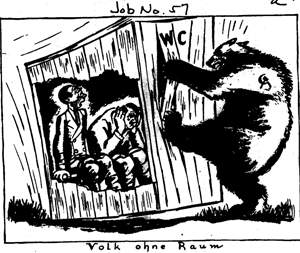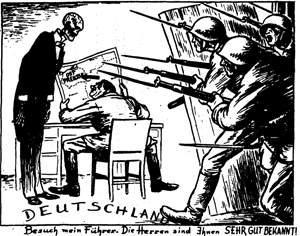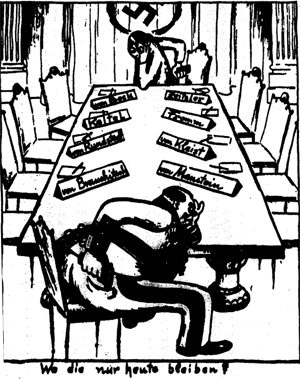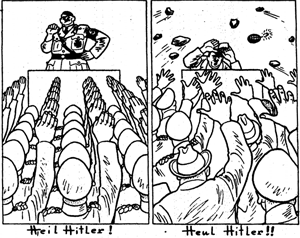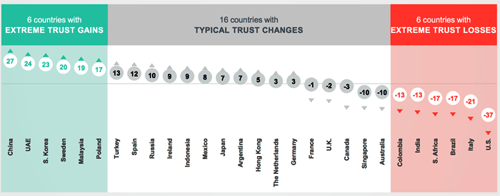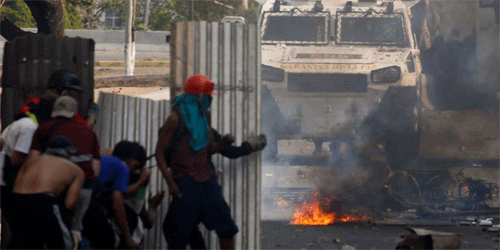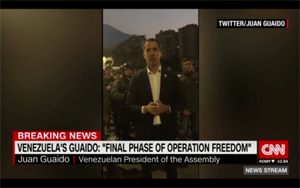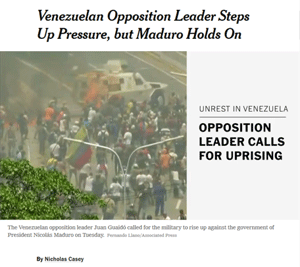Re: Washington Post’s ‘Fake News’ Guilt, by Robert Parry
Part 1 of 2
Morale Operations Branch
by Wikipedia
Accessed: 8/10/18
NOTICE: THIS WORK MAY BE PROTECTED BY COPYRIGHT
Morale Operations was a branch of the Office of Strategic Services during World War II. It utilized psychological warfare, particularly propaganda, to produce specific psychological reactions in both the general population and military forces of the Axis powers in support of larger Allied political and military objectives.
Origins
William Joseph Donovan formed the Morale Operations Branch of the Office of Strategic Services on March 3, 1943.[1] Donovan admired the perceived effectiveness of Nazi propaganda and saw the United States' lack of similar operations as a significant weakness.[2] To that end, he created the Morale Operations branch, which used many different tactics in both the informational and physical domains to sap morale, induce confusion and sow distrust within the populations of Axis countries and within the ranks of their armed forces.
Donovan held the belief that warfare should be conducted with an eye specifically to the psychological effect of both the actions and deeds of parties to a conflict both upon the constituent populations of the warring parties and the armed forces of the parties themselves, asserting that such psychological considerations are as important in devising wartime strategy as any other factor considered in planning a military campaign.[3]
In a speech delivered by then Colonel Donovan, he cites the specific importance of the psychological effect of both physical action and communication in warfare:
"The element of surprise in military operations, which is psychological warfare translated into field tactics, is achieved by artifice and stratagem, by secrecy and rapidity of information, by mystifying and misleading the enemy. When you strike at the morale of a people or any army, you strike at the deciding factor, because it is the strength of their will that determines the length of wars, the measure of resistance, and the day of final collapse."[4]
In the same speech, Donovan somewhat incorrectly cites Adolf Hitler's assertion from Mein Kampf as an example of how Nazi Germany paid considerable attention to the psychological aspects of warfare in preparation for hostilities in the late 1930s:
"The place of the artillery barrage as preparation for infantry attack will be taken, in the future, by revolutionary propaganda. Its task is to break down the enemy physically before the armies begin to function at all."[5]
Donovan's template for the organization of the Morale Operations Branch may be attributed loosely to the 'black' propaganda elements of the British Political Warfare Executive (PWE), upon which OSS personnel drew heavily for guidance in designing the makeup and mission of the Morale Operations Branch.
Though MO Branch drew a great deal of its origins from the British PWE, there was tension between the US and British agencies on the use of what was then referred to as 'Terror Propaganda.' Donovan viewed Hitler's use of the threat of overwhelming violence followed by ultimatums for surrender as tactics that could be made to backfire, and took issue with Churchill's focus on 'unconditional surrender' as the only option for Nazi Germany following an Allied victory.[6] In a document outlining the purpose of the OSS to President Roosevelt, he wrote the following:
"Espionage is not a nice thing, nor are the methods employed exemplary. Neither are demolition bombs nor poison gas, but our country is a nice thing and our independence is indispensable. We face an enemy who believes one of his chief weapons is that none but he will employ terror. But we will turn terror against him - or we will cease to exist."[7][better source needed]
This statement, and the guiding principles Donovan set down for the OSS which placed a premium on the importance of 'influence' as the primary objective of many of the OSS's operations, set the tone for the activities of the entire service during its lifespan until 1945.
Organization
The Morale Operations Branch comprised five sections: the Special Communications Detachment, the Radio Division, the Special Contacts Division, the Publications and Campaigns Division, and the Foreign Division. The Special Communications Detachment was responsible for "combat propaganda operations in coordination with the U.S. Army in Europe."[2] The Radio Division "conducted all black or clandestine radio programs."[2] The Special Contacts Division "distributed propaganda to partisan groups."[2] The Publications and Campaigns Division "produced leaflets, pamphlets, and whispering campaigns."[2] The Foreign Division "conducted miscellaneous [Morale Operations] activities abroad."[2] Collectively these divisions carried out psychological warfare operations for the U.S. Army.
The Morale Operations Branch had outposts in several locations across the globe. Usually these stations were close to U.S. Army combat stations or integrated into Army intelligence posts.[2] By 1945 the Morale Operations Branch had one station in Algeria, Egypt, France, and Britain, two in Sweden, and six in Italy.[2] The most important of these stations was in London, Britain.[2]
Relationship with other wartime information agencies
Relationship with Political Warfare Executive
The Morale Operations Branch gained a great deal of its early sources of information through its liaison relationship with the British Political Warfare Executive.[8] This relationship was to continue for the duration of the war, and would vary in intensity given the particular inclinations of various officers involved with Morale Operations in the OSS and their British counterparts. The Morale Operations Branch took much inspiration for its tactical campaigns from tactics developed by the British, some of which dealt with the regular dissemination of rumors into sources of popular media in Axis occupied or neutral countries.[9]
Relationship with Office of War Information
The US Office of War Information was an office within the Executive Branch resulting from the consolidation of many of the more overt information dissemination services managed by the US government during the war. In June 1942, the OWI gained some of the overt broadcast components of the OSS's predecessor, Donovan's Office of the Coordinator of Information, while the more covert components charged with the conduct of subversion and deception became part of the MO Branch. Among other US media notables enlisted to serve the government during the war, playwright Robert E. Sherwood played a large role in determining the character and functions of both the OWI and MO Branch.[10] Sherwood served as an advisor to both organizations, and contributed greatly to many of Donovan's plans for coordinated psychological warfare against the Axis powers throughout the war.
Archibald MacLeish, another luminary of the American media community also served a critical role in advising both the MO Branch and OWI, serving as the director of OWI's Office of Facts and Figures[11] and as senior advisor to OSS's Research and Analysis Branch on matters pertaining to Psychological Warfare strategy.[12]
The MO Branch and OWI coordinated their activities by design,[13] to the point the OWI occasionally allowed subversive content to be injected into overt OWI broadcasts in order to enhance the effect of covert MO Branch activities overseas.[14]
Relationship with Supreme Headquarters Allied Expeditionary Force Psychological Warfare Division (PWD/SHAEF)
MO Branch additionally maintained operational detachments that were attached to major maneuver units of the US military under the operational control of the Supreme Headquarters Allied Expeditionary Force. These tactical teams were divided into three distinct categories: Combat Teams, Occupational Teams and Base Teams.[15]
Campaigns
Leaflets
Fünf Minuten
The 'Fünf Minuten' leaflet campaign (translated as 'Five Minutes' from German) centered on inculcating a sense of futility within the German military and general German citizenry based on the industrial and manufacturing supremacy of the combined allied economies. The graphic leaflets dropped behind Axis lines presented audiences with facts about the number of US warplanes produced every five minutes in the United States in order to lead the audience to the conclusion that no matter how many US aircraft the Luftwaffe brought down, there were dozens more on the way. The central focus of this leaflet campaign was twofold - both to demoralize the German military by presenting them with odds that cannot be overcome, and instilling a sense of inferiority in the industrial workers that made up Germany's wartime manufacturing base.
Morale Operations Branch
by Wikipedia
Accessed: 8/10/18
NOTICE: THIS WORK MAY BE PROTECTED BY COPYRIGHT
YOU ARE REQUIRED TO READ THE COPYRIGHT NOTICE AT THIS LINK BEFORE YOU READ THE FOLLOWING WORK, THAT IS AVAILABLE SOLELY FOR PRIVATE STUDY, SCHOLARSHIP OR RESEARCH PURSUANT TO 17 U.S.C. SECTION 107 AND 108. IN THE EVENT THAT THE LIBRARY DETERMINES THAT UNLAWFUL COPYING OF THIS WORK HAS OCCURRED, THE LIBRARY HAS THE RIGHT TO BLOCK THE I.P. ADDRESS AT WHICH THE UNLAWFUL COPYING APPEARED TO HAVE OCCURRED. THANK YOU FOR RESPECTING THE RIGHTS OF COPYRIGHT OWNERS.
Morale Operations was a branch of the Office of Strategic Services during World War II. It utilized psychological warfare, particularly propaganda, to produce specific psychological reactions in both the general population and military forces of the Axis powers in support of larger Allied political and military objectives.
Origins
William Joseph Donovan formed the Morale Operations Branch of the Office of Strategic Services on March 3, 1943.[1] Donovan admired the perceived effectiveness of Nazi propaganda and saw the United States' lack of similar operations as a significant weakness.[2] To that end, he created the Morale Operations branch, which used many different tactics in both the informational and physical domains to sap morale, induce confusion and sow distrust within the populations of Axis countries and within the ranks of their armed forces.
Donovan held the belief that warfare should be conducted with an eye specifically to the psychological effect of both the actions and deeds of parties to a conflict both upon the constituent populations of the warring parties and the armed forces of the parties themselves, asserting that such psychological considerations are as important in devising wartime strategy as any other factor considered in planning a military campaign.[3]
In a speech delivered by then Colonel Donovan, he cites the specific importance of the psychological effect of both physical action and communication in warfare:
"The element of surprise in military operations, which is psychological warfare translated into field tactics, is achieved by artifice and stratagem, by secrecy and rapidity of information, by mystifying and misleading the enemy. When you strike at the morale of a people or any army, you strike at the deciding factor, because it is the strength of their will that determines the length of wars, the measure of resistance, and the day of final collapse."[4]
New York Speech
12/12/42
Psychological warfare – not a new factor in war – it’s importance greatly accentuated by conditions in modern war and by new instruments.
Since war began psychological warfare has been used. A leader has always tried to win to his standard tribes or individuals or allied nations. Political devices have been used to woo support of potential enemies, to secure compliance by threats of military action and prevent military action when these devices have failed.
When you had professional armies you sought to influence those in command by such political or diplomatic action. But with nations in arms, with civilians in uniform, the emphasis of such warfare has changed.
But it is still true that if you can stampede the leaders, the full objective may be more quickly achieved. You direct your propaganda at the civilian population, at their national emotions, because by doing so you not only involve the leaders, you not only aim at destroying the force of the war machine, but the political or military group who runs that machine.
Psychological warfare not a new device. Practiced in every phase of history – the war paint of barbarous tribes, the Trojan Horse, the Pheric elephants, the leaflets and wshipers used by Richelieu to destroy the morale of the besieged population of La Rochelle. At different times and different periods all of these devices have been used.
The element of surprise in military operations, which is psychological warfare translated into fields tactics, is achieved by artifice and stratagem, by secrecy and rapidity of information, by mystifying and misleading the enemy. When you strike at the morale of a people or an army you strike at the deciding factor, because it is the strength of their will that determines the length of wars, the measure of resistance and the day of final collapse.
We have this on both sides. In the first World War effective use was made of social and ideological warfare. But then the Allies were the masters. They had organized the warring nations that operated on three continents; they had isolated Italy from the Triple Alliance; won over the United States; secured the cooperation of Greece; forced the acceptance of a blockade which produced the economic strangulation of the enemy and they had used propaganda to accentuate racial, ethnic and class differences. They distorted the motives and methods of the enemy regime; destroyed the faith of the Central European powers in the fighting services; produced peace overtures which weakened and finally disrupted the enemy.
Between wars, the democracies had not prepared in psychological warfare because they had not prepared for war physically or morally. But Hitler did prepare, and he changed the kind of political warfare. He said: “The place of the artillery barrage as a preparation for infantry attack will, in the future, be taken by revolutionary propaganda. Its task is to break down the enemy physically before the armies begin to function at all.” And under him the Germans developed a deliberate science and strategy of psychological warfare.
THE AIM AND THE INSTRUMENTS:
In this war of machines, the human element is, in the long run, more important than the machines themselves. There must be the will to make the machines, to man the machines, and to pull the trigger. Psychological warfare is directed against that will. Its object is to destroy the morale of the enemy and to support the morale of our allies within enemy and enemy occupied countries.
One instrument is propaganda. This has more powerful instruments than ever before. The radio reaches the home, the bomber drops leaflets on the cities. Secret communications enable reports to penetrate enemy countries.
But in fighting that kind of war, it is just as important to have intelligence as in fighting in the orthodox and traditional way. There must be known the psychology of the people; the elements of resistance; the degree of cooperation which you can count upon when your divisions go in there. You must know the morale effect of air attacks against that region. You must be able not only to know the ground but to prepare it and to mobilize cooperation.
The essence of rumoring is that you know what nobody else knows and that you want everybody to know that you know what they don’t know. It is this human weakness that has to be exploited.
The ammunition of psychological warfare consists of ideas more powerful than those used by the enemy.
The Nazis have produced in Europe a large measure of grudging acquiescence that grows on successive disappointments and through the comparative barrier of distance. You must combat that with the certainty of Allied victories. What we offer must be concrete; must be translated into individual experience. They must be able to see some pattern of existence after the war.
This is a question of today and tomorrow and not of an indefinite future, because we have to arm the people of Europe with the conviction that our cause is their cause.
Donovan on psychological warfare
In the same speech, Donovan somewhat incorrectly cites Adolf Hitler's assertion from Mein Kampf as an example of how Nazi Germany paid considerable attention to the psychological aspects of warfare in preparation for hostilities in the late 1930s:
"The place of the artillery barrage as preparation for infantry attack will be taken, in the future, by revolutionary propaganda. Its task is to break down the enemy physically before the armies begin to function at all."[5]
Donovan's template for the organization of the Morale Operations Branch may be attributed loosely to the 'black' propaganda elements of the British Political Warfare Executive (PWE), upon which OSS personnel drew heavily for guidance in designing the makeup and mission of the Morale Operations Branch.
Though MO Branch drew a great deal of its origins from the British PWE, there was tension between the US and British agencies on the use of what was then referred to as 'Terror Propaganda.' Donovan viewed Hitler's use of the threat of overwhelming violence followed by ultimatums for surrender as tactics that could be made to backfire, and took issue with Churchill's focus on 'unconditional surrender' as the only option for Nazi Germany following an Allied victory.[6] In a document outlining the purpose of the OSS to President Roosevelt, he wrote the following:
"Espionage is not a nice thing, nor are the methods employed exemplary. Neither are demolition bombs nor poison gas, but our country is a nice thing and our independence is indispensable. We face an enemy who believes one of his chief weapons is that none but he will employ terror. But we will turn terror against him - or we will cease to exist."[7][better source needed]
This statement, and the guiding principles Donovan set down for the OSS which placed a premium on the importance of 'influence' as the primary objective of many of the OSS's operations, set the tone for the activities of the entire service during its lifespan until 1945.
Organization
Dr. McKay
SECRET
December 4, 1942
Memorandum to Dr. Rogers
From: R.H. Knapp
Subject: The Use of Terror Propaganda
In line with our discussion of yesterday, I should like to put into writing the following thoughts:
Terror propaganda, while immensely successful under proper conditions, may well be used imprudently to increase the resolution and determination of the enemy. This is especially true when it is not accompanied by reassurances to the innocent or helpless in enemy territory.
It has been the aim of German and Italian domestic propaganda to picture the war to their peoples as al alternative between total victory or annihilation. The strategy is obvious. If all Germans and Italians can be persuaded of this view, then even those who have been strongly unsympathetic with the Nazi and Fascist regimes will now have, of necessity, common cause with them, and the unity and determination of the enemy nations as a whole will be increased.
In presenting unalloyed terror propaganda to the enemy, we are, I think, furthering the very conviction which the enemy is trying to foster among their own people. The case of Italy at this moment is an excellent example. Churchill’s declaration of intentions must be considered terroristic. Had it been made in conjunction with concrete assurances regarding the intentions of the allied nations to deal fairly and humanely with the Italian people, and at a time when the Italian people, or elements of them, would have some prospect of successful rebellion, its effect might be otherwise. As it now stands, there is great danger that this declaration may drive the Italians to their leaders, and into closer cooperation with Germany. Already, of course, the Germans have taken occasion to indicate to the Italian people that Churchill’s declarations merely confirm their predictions that if an allied victory is achieved, both Italy and Germany will be subjected indiscriminately to brutal retaliations.
In general, I think terror propaganda should be employed only under the following circumstances:
1. When there is the possibility of producing demoralizing panic. (A comparatively rare situation.)
2. When it is presented in conjunction with reassurances to innocent or helpless within the enemy population.
3. When it is presented at such a time that elements of the enemy population have reasonable prospect of being able to operate effectively against their leaders, and thus demonstrate their loyalty to the allied cause and disaffection toward their leaders.
Conversely, terror propaganda should not be employed in the following situations:
1. When there is no hope to produce immediate panic.
2. When it is not accompanied by reassurances to the innocent or helpless within the enemy nation.
3. When there is no possibility of action by those within enemy territories who oppose the ruling regime.
Clearly, the factor of timing rules the advisability of employing terror propaganda. If properly timed, it may produce panic; if not, it may force additional cohesion among the enemy. If properly timed, and accompanied by reassurances, it may precipitate revolt within the enemy nation; if not, it may drive them into common cause with their leaders.
Use of Terror Propaganda
The Morale Operations Branch comprised five sections: the Special Communications Detachment, the Radio Division, the Special Contacts Division, the Publications and Campaigns Division, and the Foreign Division. The Special Communications Detachment was responsible for "combat propaganda operations in coordination with the U.S. Army in Europe."[2] The Radio Division "conducted all black or clandestine radio programs."[2] The Special Contacts Division "distributed propaganda to partisan groups."[2] The Publications and Campaigns Division "produced leaflets, pamphlets, and whispering campaigns."[2] The Foreign Division "conducted miscellaneous [Morale Operations] activities abroad."[2] Collectively these divisions carried out psychological warfare operations for the U.S. Army.
The Morale Operations Branch had outposts in several locations across the globe. Usually these stations were close to U.S. Army combat stations or integrated into Army intelligence posts.[2] By 1945 the Morale Operations Branch had one station in Algeria, Egypt, France, and Britain, two in Sweden, and six in Italy.[2] The most important of these stations was in London, Britain.[2]
Relationship with other wartime information agencies
Relationship with Political Warfare Executive
The Morale Operations Branch gained a great deal of its early sources of information through its liaison relationship with the British Political Warfare Executive.[8] This relationship was to continue for the duration of the war, and would vary in intensity given the particular inclinations of various officers involved with Morale Operations in the OSS and their British counterparts. The Morale Operations Branch took much inspiration for its tactical campaigns from tactics developed by the British, some of which dealt with the regular dissemination of rumors into sources of popular media in Axis occupied or neutral countries.[9]
Relationship with Office of War Information
The US Office of War Information was an office within the Executive Branch resulting from the consolidation of many of the more overt information dissemination services managed by the US government during the war. In June 1942, the OWI gained some of the overt broadcast components of the OSS's predecessor, Donovan's Office of the Coordinator of Information, while the more covert components charged with the conduct of subversion and deception became part of the MO Branch. Among other US media notables enlisted to serve the government during the war, playwright Robert E. Sherwood played a large role in determining the character and functions of both the OWI and MO Branch.[10] Sherwood served as an advisor to both organizations, and contributed greatly to many of Donovan's plans for coordinated psychological warfare against the Axis powers throughout the war.
July 25, 1941
Memorandum
To: Robert Sherwood
From: Nelson Poynter
MAJOR PREMISES
1. World public opinion is influenced most by spot news. The battle is for best short and medium wve radio program, and page one of the newspapers of the world.
2. Dynamic action and tough utterances backed by deeds are the most potent foreign propaganda today. All other propaganda effort in the radio and press should be secondary to the battle for "page one."
3. A government agency operating 24-hours a day, seven days a week is needed to coordinate intelligence and to stimulate the making of news at the source, chiefly the numerous government departments. If this can be achieved we can avoid a ministry of propaganda. It is undesirable to have a ministry of propaganda because:
a. Congressional resentment.
b. Domestic repercussions.
c. Central clearance will impede rather than speed up official statements and action.
d. Central clearances will be resented by government officials who would feel subordinated to the ministry of propaganda.
e. It is desirable at times for high government officials to make statements without responsibility to the White House. A ministry of propaganda is bound to have White House responsibility attached to it in the public mind, regardless of technical fact.
4. The U.S. government must make every effort to avoid taking over short and medium wave radio stations.
5. The U.S. government, as a government, must keep its hands off the broadcasting of spot news, because:
a. Peoples of the world have greater confidence in news reports from U.S. than from any other country for the very reason that they are considered independent of the government.
b. If government news men start handling news it may ultimately be distorted and we will lose audience as a result of lost confidence in the news. News men of high integrity, sympathetic to, but not of the government, are the men to handle the spot news reports.
c. The press of this country, and what’s left of the free press of the world do not like government tinkering with the news. Most of the editors of the totalitarian press even respect the ability of this government to keep its hands off the news. This is something to build on.
6. A central news room and central broadcasting studio is desirable for all or most all of the short-wave transmitters, because:
a. It is almost impossible to find enough good news and linguistic talent to staff seven different short wave news rooms.
b. It is impossible to relay all necessary information from Washington to seven scattered short-wave news rooms.
c. Difficulties of monitoring, of checking sabotage, of innuendo and of language in seven scattered operations. Master switches in central control room can avert many of these difficulties.
IMMEDIATE STEPS RECOMMENDED TO IMPROVE OUR PRESENT POSITION IN WORLD RADIO AND HEADLINE BATTLE.
1. A crack, central news studio with mikes to all short-wave transmitters.
2. Division of world areas among the seven transmitters according to need of government rather than latent commercial desires of broadcasters.
3. Flexibility which would enable all transmitters to broadcast same program simultaneously or on seven different beams in seven different languages simultaneously.
4. Pool news and newscasting talent of short-wave stations, augmenting if necessary.
5. Set up master schedule embracing all stations according to best interests of government.
6. Donovan office to set up New York liaison office consisting of a few crack newsmen to feed hunches, and suggest direction and emphasis, based on intelligence from Washington. This office also to provide checks against sabotage of news report in addition to checks which broadcasters themselves would set up.
7. New York Donovan news operation would be tied into Washington Donovan spot news operation. Crack men at both ends must have unimpeachable integrity, as well as a certain amount of sales ability to feed statements, wise-cracks and even suggest actions that will curl into headlines on radio and newspapers of the world. Such a staff can accelerate clearances and actions within our government without the necessity of building up a ministry of propaganda. We will have something better, faster and more flexible than Nazis. With ingenuity such an operation can make headlines from other government departments than White House and State department that presently carry most of the headline burden with resulting delays and bottlenecks. Instead of having active resistance of other departments, Donovan office can have their active support and gratitude because it can show them how they, too, can participate on the propaganda front.
IMMEDIATE STAFF NEEDED
Assume that all news processors, translators, initial checkers and newscasters will be paid for by broadcasters. Private payroll will avoid numerous government complications and enable employment of staff members who cannot afford to work for government salary.
Thus N.Y. Donovan news office immediately requires only:
Three key news men to divide tricks around clock, one to be boss of N.Y. office.
Three assistants when right three key men have been found.
Six full-time linguists for double checking, basic languages.
Part-time linguists to double check non-basic languages.
Washington Donovan spot news operation will need initially:
Spot News Director – including N.Y. Spot News operation.
Three key news men dividing up the clock.
Add, as good men found, six assistants to maintain liaison and help activate news from other government agencies.
ASSUMPTION RE: WASHINGTON STAFF – FCC Listening Post will have a spot operation to skim off highlights of opposition’s propaganda trends in various parts of the world, and therefore Donovan office will receive its initial short wave listening intelligence in fairly refined form. If FCC does not provide such facilities, add three key men, and twelve crack, multi-lingual listeners who can be trained to give news operation what is desired.
DILEMMAS TO BE RESOLVED:
1. Short-wave broadcasters reluctant to divide up world areas according to needs of government rather than their commercial ambitions.
2. Short-wave broadcasters lose money. Government proposing an even more expensive news operation for them.
Who shall pay line charges?
Who shall pay for better talent for news and newscasters?
Who shall pay for additional electricity, engineering time, and maintenance for broadcasting more hours per day.
We very roughly estimate such additional costs will run to $500,000 a year. (I have not had opportunity to check the electricity, engineering maintenance. This estimate may be low.)
The government has the money. Question is whether broadcasters want to accept it, and whether is sound policy for government get into broadcasting virtually as paying sponsor.
POSSIBLE SOLUTIONS:
1. Broadcasters, A.T.&T., power companies to share this increased expense.
2. Government to buy some official time for official communiqué, but not news time, and thus cover additional expense, or at least part of it. This would not be entirely devious. There are times when more outright official news should be pumped out, than it is desirable to feed through normal news channels without losing audience, without making the news smack too much of official propaganda.
Almost every week some government official is making a speech which it is desirable to broadcast by short-wave, or rebroadcast at a more favorable time. Thus the government can legitimately use the permanent lines which would be available for newscasting on a non-government basis.
Nelson Poynter
301 Taylor Drive
Alexandria, Va.
Telephone: Temple 2739
or
The St. Petersburg Times
St. Petersburg, Fla.
‘Phone: 5101
No ministry of propaganda
Archibald MacLeish, another luminary of the American media community also served a critical role in advising both the MO Branch and OWI, serving as the director of OWI's Office of Facts and Figures[11] and as senior advisor to OSS's Research and Analysis Branch on matters pertaining to Psychological Warfare strategy.[12]
The MO Branch and OWI coordinated their activities by design,[13] to the point the OWI occasionally allowed subversive content to be injected into overt OWI broadcasts in order to enhance the effect of covert MO Branch activities overseas.[14]
OFFICE OF STRATEGIC SERVICES
WASHINGTON, D.C.
October 14, 1943
To: Lt. Patrick Dolan
From: Robert H. Knapp
Subject: OWI Aid in Dissemination of Rumors
You will be interested to know that we have struck a deal with Doob of O.W.I. whereby he now is able to plant selected rumor items in O.W.I. for newscasts. Accompanying is a transcript of the German news broadcast of October 8th containing one of our rumors. This is found on page 9 and states in effect that party leaders have been misappropriating the houses of bombing evacuees from Bremen.
We are continuing to supply Doob with a considerable amount of material and are greatly encouraged over the use of it.
Incidentally, the programs are rebroadcast by B.B.C. Naturally this arrangement with Doob is on a purely informal and unofficial level and should be kept in the family.
attachment
from PS
OWI black propaganda memo, 1943[i]
Relationship with Supreme Headquarters Allied Expeditionary Force Psychological Warfare Division (PWD/SHAEF)
MO Branch additionally maintained operational detachments that were attached to major maneuver units of the US military under the operational control of the Supreme Headquarters Allied Expeditionary Force. These tactical teams were divided into three distinct categories: Combat Teams, Occupational Teams and Base Teams.[15]
United States SECRET Equals British MOST SECRET & SECRET
MEMORANDUM
12 November 1943
SUBJECT: PWB Field Teams - COMBAT TEAMS.
FROM: Frederick Oechsner
1. The PWB field set-up for the Sicilian campaign provided for three "waves" of teams, viz:
a. Combat Teams (or reconnaissance)
b. Occupational (or dissemination) Teams
c. Base (or permanent) Teams.
The make-up and activities of these various teams would obviously vary according to the problems faced, e.g. where the combat area was rural or urban in nature, densely or sparsely populated, advanced or backward in culture etc.
2. COMBAT TEAMS:
Combat teams were made up of three to five men, mixed military and civilian. One was attached to the 7th (American) Army under John Whittaker of MO, civilian, with one British and one American officer; and one attached to the 8th (British) Army under Lt. Col. McFarlane of PWE with a British and American officer. These teams were provided with Jeeps and trailers and with full field equipment for self subsistence and protection for anything up to five days or a week. Their duties were manifold, including not only the gathering of intelligence and the active prosecution of psychological warfare, but the "selling" of propaganda and psychological warfare to Field Commanders. It may be said that the Combat teams amply justified themselves in the Sicilian operation. The intelligence they procured was invaluable to the Base Areas for the preparation of radio programs and strategical leaflets, of black radio programs, as well as for tactical leaflets in the field; most of the intelligence procured was also of value to G-2 (with whom the Combat teams worked in close cooperation) and Field Security.
3. The essential duties of the Combat teams might be outlined as follows:
a. To locate, ear-mark for later use and to seize, when necessary, radio broadcasting stations, printing presses (for leaflets, posters, etc), newspaper plants (for the issuance of newspapers), stocks of paper and cinemas.
b. To locate and procure by force, if necessary, the essential parts of radio stations, printing presses, newspaper plants, which may have been removed by the enemy.
c. To estimate the damage caused by the enemy and the parts necessary and probable time required to repair the plants to usefulness.
In Siciliy some of us felt that it was desirable not to high pressure the population with posters, merely giving them a new type of political propaganda when what they really needed was a relief from high pressure propaganda after ten to twenty years of it.)
e. To collaborate further with the Civilian Administration Authorities in any "conditioning" of the local population that is required.
f. To enlist further local reliable assistants in the operation of radio stations, newspapers, printing presses, etc.
g. To take in whatever field equipment may be necessary (particularly mobile printing presses and loudspeaker units) to service combat teams in their further operations up forward.
5. The lessons to be learned from the experiences of the Occupational teams may be roughly described as follows:
a. The necessity of organizing a thoroughly reliable communications set-up as between the Advance (occupational team) base and the Base Hqs. for the transmission of material as well as for the transmission of Combat team material which the teams may not have been able to get through themselves.
b. The necessity of ascertaining accurately, by means of public opinion testing surveys, the attitude of the population in the area for purposes of propaganda. Such attitudes will have to be gauged by the Occupational teams more fully than the Combat Teams will be able to do; moreover an independent test is necessary for the reason that the attitude of the population may actually have changed between the time that the Combat team left and the Occupational team arrived.
c. The necessity of organizing good transportation of Advance Base Headquarters, not only for members of the Advance Base staff but also for the repair of the vehicles of Combat teams.
d. The necessity of remaining in close contact with G-2, Field Security, Civilian Administration Authorities and other authorities in the area.
e. The necessity of forming a radio program and newspaper content which will appeal to, rather than in any way antagonize, the population which will just be coming out from under the influence of several years of Axis propaganda.
f. The necessity of selection motion pictures for display in cinemas in the area from the same point of view as in e. above.
6. The functions of personnel of the Advance Headquarters (Occupational) Group were as follows:
Commanding Officer
Deputy Commanding Officer
Administration Section (under a British Captain) responsible for:
Billeting
Mess
Transportation
Security and Duty Officers
Equipment
Personnel
Secretariat
Daily Activities Reports
Liaison with Amgot
Dissemination Section (under a civilian) responsible for:
Press
Radio (white)
Radio (black)
Motion pictures
Mobile Press
Local printing work
Leaflets
Loudspeakers
Propaganda displays
Photographs (front photographs as well as laboratory work at Advance Hqs.)
Posters
Intelligence (under an American Army Captain) responsible for:
Monitoring
Liaison with G-2
Intelligence reports to Hq. Algiers, Tunis, London and Washington.
Communications (under an American Army Captain) responsible for:
Technical operation of the local radio
Technical operation of mobile radio
Technical operation of the loudspeaker unit
Technical operation of the intercept unit
MEMORANDUM
12 November 1943
SUBJECT: PWB Field Teams – OCCUPATIONAL TEAMS
FROM: Frederick Oechsner
1. The PWB field set-up for the Sicilian campaign provided for three “waves” of teams, viz:
a. Combat Teams (or reconnaissance)
b. Occupational (or dissemination) Teams
c. Base (or permanent) Teams.
The make-up and activities of these various teams would obviously vary according to the problems faced, e.g. where the combat area was rural or urban in nature, densely or sparsely populated, advanced or backward in culture etc.
2. OCCUPATIONAL TEAMS:
In Sicily established Advance Base Headquarters for the taking over of PWB activities from the Combat teams: they also served as field bases for the Combat teams. In Sicily the main Advance Headquarters was established at Palermo with a sub-section in Catania; the Palermo staff (including 25 persons in the mobile broadcasting company and about 10 persons shuttling to the forward areas) totaled 75 persons.
3. The Occupational team, which set-up Advance Headquarters under Frederick Oechsner of MO, proceeded from Tunis by troop transport to Syracuse on D plus 20, proceeded by airplane or motor vehicle (the mobile broadcasting company going under its own power) to Palermo and Catania where it took over there the Headquarters established by the Combat teams attached respectively to the 7th and 8th Armies.
4. The essential duties of the Occupational teams might be outlined as follows:
a. To open and commence the operation of radio stations, printing presses, newspapers and cinemas which have been located by the Combat TEams.
b. To conduct whatever white or black field radio broadcasting operations are indicated (mobile broadcasting units).
c. To serve Base Headquarters more amply than the Combat Teams were able to do with intelligence, intelligence evaluation, open radio program material and a steady flow of photographs.
d. To expand the display of posters (again only, of course, after it has been decided that it is desirable to use posters in any particular locality.
d. To report on all these matters to Base Headquarters.
e. To visit the Headquarters of enemy political organizations and seize whatever documents and other materials useful in the conduct of psychological warfare such as name lists, instructions and circulars, annual reports, etc.
f. To make direct contact with political leaders, friendly and unfriendly, and local dignitaries, for the purpose of securing the assistance of these persons or to securing their arrest through the appropriate field authorities (Field Security).
g. To distribute hand-bills and put up posters, where putting up of posters is desirable.
h. To collaborate with Civilian Administration Authorities in the printing of circulars and proclamations.
i. To interrogate prisoners for information useful at Base Hqs. in the preparation of radio programs and leaflets, or in the preparation of leaflets in the field.
j. To send full and continuous reports back to Base Hqs. by wireless and courier on all matters of morale among the population, including full descriptive messages suitable for using in open propaganda programs, as well as evaluation of material such as captured documents and prisoner of war interrogation.
k. To actually prepare all tactical leaflets for use against the immediately opposing enemy troops and the delivery of these leaflets by mortar or airplane.
l. To secure reliable local personnel to help in re-opening radio stations, printing presses, newspaper plants and cinemas.
m. To spread tactical rumours amongst the population.
4. The primary lessons to be learned from the experiences of the Combat Team in Sicily might be roughly described as follows:
a. Teams should go in on “D” Day, not later.
b. They may be of military and civilian make-up, but preferably under an officer of the rank of at least a Major or Lt. Colonel.
c. It is not necessary for all members of the team to be armed, but the teams as such should be adequately protected against emergencies.
d. All members of the team should speak fluently the language of the country in which they are going to operate.
e. They should be fairly young men (I should suggest between the ages of 28 and 45), in good physical condition to withstand long hours of work under arduous field conditions, should be men of coolness, poise, judgment and courage.
f. They should be fully equipped with [illegible] command cars, probably with trailers, so as to carry [illegible] but a supply of posters and hand-bills to distribute among [illegible] populations.
g. They should be supplied, if possible, with lists of [illegible] reliable and non-reliable, in the communities where they are going to [illegible] liberate.
h. They should have adequate communications with their [illegible] probably preferably via their own wireless sets; and such team should have a sturdy reliable radio receiver for monitoring enemy broadcasts in the field.
i. The training of the members of the Combat Teams should [illegible] some close combat and small arms practice as well as a general familiarity with the principal types of booby-traps and mines. It would also be desirable, of course, to have drivers who are familiar with automobile mechanics, as well as obviously a man capable of handling wireless telegraphy, if a transmitter is included in the equipment.
j. If there is enough time before the commencement of an operation, it would be highly desirable to have the Combat teams actually trained with the units to which they are to be attached in the field. Members of the Combat teams can thus get to know the officers with whom they are later going to have to work under combat conditions; conversely, the officers would become familiar with the personalities and methods of the team.
k. In Sicily there was only one team attached to the 7th Army and one to the 8th Army. Experience showed that in view of the necessity of the Combat teams keeping contact with various units, and meeting the problems of these units on different fronts, it is probably necessary to have a greater number of teams. Depending, of course, upon the size of the new team, the ideal might be one per Corps, or conceivably one per Division.
l. Leaflet shells are not yet perfect, though they permit a more accurate placing of leaflets than by plane (wind-drift, deflection of plane by ground force etc).
m. Loudspeakers are in general not desired at the front; they draw fire and are useful only in delivering a certain specific message to a certain specific unit known to be opposite one’s position; it is probably well to have a loudspeaker unit available if it should be called for in a particular operation.
n. Leaflets remain the single most important means of attack. In order to use them for tactical uses (especially gun delivery) mobile printing units are necessary which can be run right up to the front for work directly next to the leaflet gun.
o. The reporting functions of the team (primarily the sending back for Base radio programs of field reports; description of reactions of populations to liberation, battle descriptions, etc) needs strengthening.
p. A good make-up for Combat teams might be: one officer (probably Lt. Colonel) for constant liaison with Army Field Headquarters, G-2 use, [illegible] Intelligence man for centralizing and evaluating field intelligence (P/W interrogation, captured documents, interviews with agents etc) for field Base Headquarters and tactical (leaflet) use; and for general reports for Base radio programs; one radio man to locate radio stations, check equipment, power, operating personnel, extent of damage, and report back to Base; one movie man (where large cities or towns lie in the combat area) to check movie facilities and report back to Base.
MEMORANDUM
12 November 1943
SUBJECT: PWB Field Teams – BASE SECTION
FROM: Frederick Oechsner
1. The PWB field set-up for the Sicilian campaign provided for three "waves" of teams, viz:
a. Combat (or reconnaissance) tEAMS
b. Occupational (or dissemination) Teams
c. Base (or permanent) Teams.
The make-up and activities of these various teams would obviously vary according to the problems faced, e.g. where the combat area was rural or urban in nature, densely or sparsely populated, advanced or backward in culture etc.
2. BASE TEAMS:
The work of the Base or permanent Section is to take over the operation of radio, printing, newspapers, cinemas and other propaganda activities in an occupied territory on a permanent basis, leading eventually to turning over all these activities to local personnel with perhaps only one or two FWB representatives as supervisors. The Base team obviously remains in close contact with Civil Affairs Authorities; in effect the work of PWB personnel is to continue the “conditioning” of the occupied population in conformity with Civil Affairs “Administration” of the area.
[i]Psychological Warfare Branch Field Teams Memo
Campaigns
Leaflets
Fünf Minuten
The 'Fünf Minuten' leaflet campaign (translated as 'Five Minutes' from German) centered on inculcating a sense of futility within the German military and general German citizenry based on the industrial and manufacturing supremacy of the combined allied economies. The graphic leaflets dropped behind Axis lines presented audiences with facts about the number of US warplanes produced every five minutes in the United States in order to lead the audience to the conclusion that no matter how many US aircraft the Luftwaffe brought down, there were dozens more on the way. The central focus of this leaflet campaign was twofold - both to demoralize the German military by presenting them with odds that cannot be overcome, and instilling a sense of inferiority in the industrial workers that made up Germany's wartime manufacturing base.
IN AMERIKA
alle funf Minuten
ein neues Flugzeug!
Das amerikanische Kriegsproduktionsamt gab am 4. Dezember amtlich bekannt:
.. Im November wurden in den Vereinigten Staaten 8.789 Militarflugzeuge fertiggestellt” – dies bedeutet alle funf Minute nein neuoo Flugzeug.
Seit. Juli 1940 wurden 140,000 Militarflugzeuge in den Vereinigten Staaten erzeugt.
Die amerikanische Production ist bombensicher. Sie steigt standing.
In den Vereinigten Staaten warden jahrlich ungefahr 100,000 Piloten ausgebildet.
Funfzehn amerikanische Luftflotten stehen heute im Kampf.
IN AMERICA
every five minutes
a new plane!
The American War Production Office officially announced on December 4:
.. In November, 8,789 military aircraft were completed in the United States "- this means no jungoo plane every five minutes.
Since. In July 1940, 140,000 military aircraft were produced in the United States.
American production is bombproof. She is standing up.
In the United States, approximately 100,000 pilots are trained each year.
Fifteen American air forces are fighting today.
Fünf Minuten leaflet
Your Comrades are Okay!
Most German soldiers who get into captivity here in Italy know that they will be treated fairly. Nevertheless many of them say: "I didn't think it would be this good!
We allied soldiers value the German frontline soldier as a courageous opponent. That is why you can count on decent treatment in captivity.
Treatment of Prisoners of War
1. German PWs are removed immediately out of the battle-zone.
2. They receive the same rations and or hospital care as our own troops.
3. Their families are notified as soon as possible through the Red Cross. Postal communications with home are speedy and reliable.
4. After the end of the war PWs will see their homes again.
YOU HAVE THE CHOICE!
WHY AM I HERE?
That is what many a soldier of the 305th Infantry-Division is asking?
HERE IS THE ANSWER:
The 305th Inf’ Division serves as Cannon Fodder.
HERE ARE THE PROOFS:
Other German divisions have been battered in Italy. Some of them were sacrificed for a second time: First at Stalingrad, then here in Italy. Many regiments have lost here up to 70% of their men. Just as these, the 305th Inf. Division was already sacrificed once at Stalingrad.
The allied artillery is so superior that German soldiers are talking about a “constant allied fire-magic.” For every German shell 20 allied shells are fired.
The German Luftwaffe is nowhere. German soldiers are fighting without air cover. But the Allies have countless bombers, pursuit planes and the “tough double-rumpers.” The allied flyers go up 20 times as often as the Germans.
HERE IS YOUR OWN POSITION:
The 305th Division has not been put into the lines to attack. Its job is to win time – for others. And what is worse: The German leaders know it.
The 305th Division has an unusually high number of Poles, Yugoslavs, Greeks and Austrians. First foreigners work in German factories. Now foreigners are to fight on the German front. Many companies are full of these foreigners. Only units doomed to sacrifice go into battle with so many “Volksdeutsche.”
The 305th Division, completely wiped out at Stalingrad couldn’t count on veteran fighters. It consists largely of very young recruits.
The 305th Division went through the Genoa region in August. At that time communications still looked a bit better. Today lines of communication behind the 305th Inf. Division are being battered daily by our air force.
HERE IS THE CONCLUSION:
THE 305TH INF/ DIVISION IS CANNON FODDER!
WHAT IS THE GERMAN SAYING?
What isn’t the German saying, God damn all of them!
Yes, the Svabs are asking us to pay their debts. If you made debts, you should pay even if it hurts; even if you almost die in paying it. And if we don’t pay, it will be just too bad, and they declare war and take our country. You can take your fucking mother, but not our country.
They are frightening us with war, the ones who need seven to fight a rabbit.
Take it easy, German, shrink a little, because you may find your man, and if you cannot stay in your skin, we shall take you out of it.
You had been here for love, now you want to come to fight. It is all right, come and come fast. We shall see who is going to be sorry.
We can give you one good piece of advice. Come on very long legs, to be able to take long steps in time, we have you on the run.
We don’t use rifles against you; just a stick, like a dog, and we shall beat you and not even a nerve of ours will budge.
BULGARIA, WAKE UP! THE END OF THE WAR IS COMING!
The help and the victims we are giving daily will not postpone the fall of Germany and that of her allies. The Germans have understood a long time ago, that the war is lost for them – they declare it openly now. We, however, continue to execute their orders, and like fools, follow them towards ruin.
It’s about time that we put an end to the criminal activity of our government. It’s necessary that we break with Germany …. AT ONCE. We can still withdraw and ….
STOP THE DESTRUCTION OF OUR CITIES
BETTER OUR RELATIONS WITH RUSSIA
RENEW OUR GOOD RELATIONS WITH THE UNITED STATES
AVOID THE INEVITABLE CIVIL WAR
STOP THE SHEDDING OF BULGARIAN BLOOD.
ALLIANCE WITH GERMANY – THE END OF INDEPENDENT BULGARIA.
FOL
We had been dumbbells long enough; we shall now be soldiers!
It was enough from ocarina; let’s have the war trumpets.
They hit us in the face, and kick us from behind. My country, how long do you want to take it? Don’t you wake up until the stormy skyi put you on fire by lightning. My country, how can the words of the thick-headed and small-hearted keep you in eternal brakes?
Or is it the way they say that the Hungarians from weakness and cowardice are not able to fight and have no will for it?
It is a lie, a very dirty lie; the same way that your tongue is.
The Hungarians, they don’t boast or rage openly, but they are quiet, full with internal fire, like their wine.
I wish there were a fight, and our blood could flow. You will see that the enemy shall die from the very drop of it.
Hurry up to bring your fame back to the sunshine which was put underground and was sullied by the German intrigue and rule.
Take your sabers out of their sheaths, the way the sun comes out of the clouds.
They should become blind and will become blind, those who look at it.
We had been dumbbells long enough; we shall now be soldiers!
It was enough from ocarina; let’s have the war trumpets.
Leaflet samples
